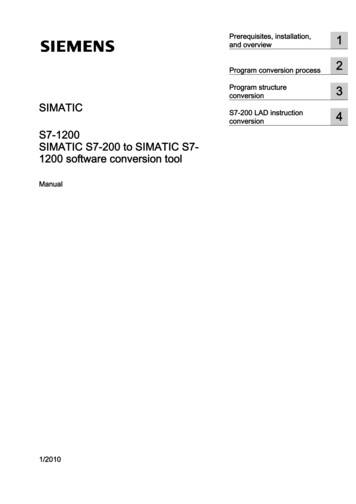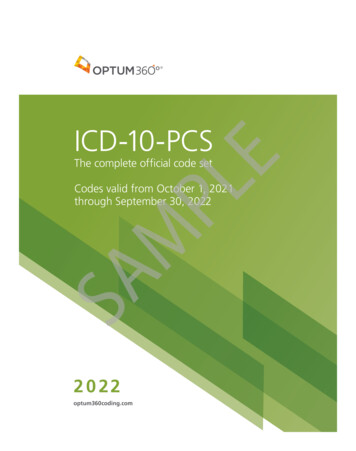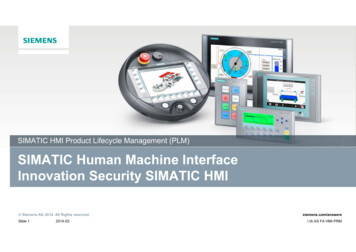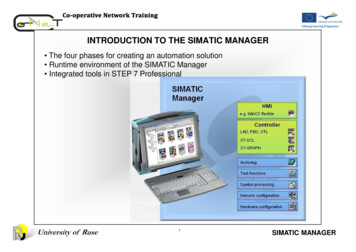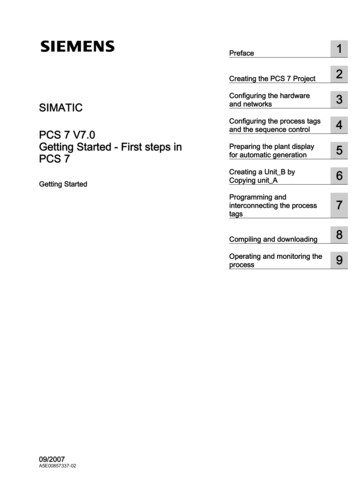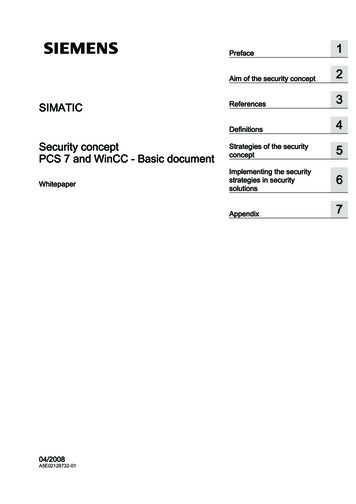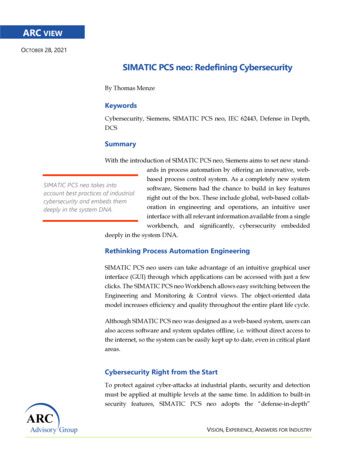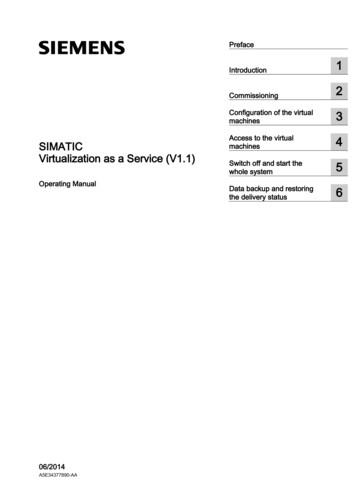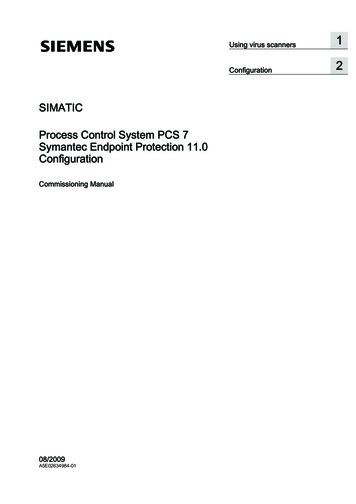
Transcription
Using virus scannersSIMATIC Process Control System PCS 7 Symantec Endpoint Protection 11.0 ConfigurationSIMATICProcess Control System PCS 7Symantec Endpoint Protection 11.0ConfigurationCommissioning Manual08/2009A5E02634984-0112Configuration
Legal informationLegal informationWarning notice systemThis manual contains notices you have to observe in order to ensure your personal safety, as well as to preventdamage to property. The notices referring to your personal safety are highlighted in the manual by a safety alertsymbol, notices referring only to property damage have no safety alert symbol. These notices shown below aregraded according to the degree of danger.DANGERindicates that death or severe personal injury will result if proper precautions are not taken.WARNINGindicates that death or severe personal injury may result if proper precautions are not taken.CAUTIONwith a safety alert symbol, indicates that minor personal injury can result if proper precautions are not taken.CAUTIONwithout a safety alert symbol, indicates that property damage can result if proper precautions are not taken.NOTICEindicates that an unintended result or situation can occur if the corresponding information is not taken intoaccount.If more than one degree of danger is present, the warning notice representing the highest degree of danger willbe used. A notice warning of injury to persons with a safety alert symbol may also include a warning relating toproperty damage.Qualified PersonnelThe product/system described in this documentation may be operated only by personnel qualified for the specifictask in accordance with the relevant documentation for the specific task, in particular its warning notices andsafety instructions. Qualified personnel are those who, based on their training and experience, are capable ofidentifying risks and avoiding potential hazards when working with these products/systems.Proper use of Siemens productsNote the following:WARNINGSiemens products may only be used for the applications described in the catalog and in the relevant technicaldocumentation. If products and components from other manufacturers are used, these must be recommendedor approved by Siemens. Proper transport, storage, installation, assembly, commissioning, operation andmaintenance are required to ensure that the products operate safely and without any problems. The permissibleambient conditions must be adhered to. The information in the relevant documentation must be observed.TrademarksAll names identified by are registered trademarks of the Siemens AG. The remaining trademarks in thispublication may be trademarks whose use by third parties for their own purposes could violate the rights of theowner.Disclaimer of LiabilityWe have reviewed the contents of this publication to ensure consistency with the hardware and softwaredescribed. Since variance cannot be precluded entirely, we cannot guarantee full consistency. However, theinformation in this publication is reviewed regularly and any necessary corrections are included in subsequenteditions.Siemens AGIndustry SectorPostfach 48 4890026 NÜRNBERGGERMANYA5E02634984-01 08/2009Copyright Siemens AG 2009.Technical data subject to change
Table of contents12Using virus scanners . 51.1Preface.51.21.2.11.2.21.2.31.2.4Using virus scanners.6Introduction .6Definitions and information .6Principle structure of the virus scanner architecture.7Using antivirus software.8Configuration . 92.1Introduction .92.2Client Modules .92.3Policies.92.4Virus Definition le System Auto-Protect .12File System Auto-Protect .12File System .12Email Protection .18Antispyware Protection – TruScan Proactive Threat Scans .19Quarantine settings.21Report Submission settings .23Miscellaneous settings.242.6Client Administrator and Tamper Protection Options .282.7Endpoint Console Firewall Settings .312.8Endpoint Intrusion Detection Settings.33Symantec Endpoint Protection 11.0 ConfigurationCommissioning Manual, 08/2009, A5E02634984-013
Using virus scanners1.11PrefaceImportant information about this whitepaperThe compatibility of the virus scanners recommended for PCS 7 and WinCC has been testedwith the systems. The recommended settings for these virus scanners have been chosen toensure the reliable real time operation of PCS 7 is not adversely affected by the virusscanner software.These recommendations describe how to discover and make effective as comprehensivelyas possible the currently known, best possible compromise between the target, virus anddamage software, and ensure an as determinable as possible time response of the PCS 7control system can be achieved in all operating phases.If you choose different settings for the virus scanner, this could have negative effects on thereal-time behavior.Purpose of this documentationThis documentation describes the recommended settings for virus scanner software incombination with PCS 7 and WinCC following the virus scanner installation.Required knowledgeThis documentation is aimed at anyone who is involved in configuring, commissioning andoperating automated systems based on SIMATIC PCS 7 or WinCC. Knowledge ofadministration and IT techniques for Microsoft Windows operating systems is assumed.Validity of the documentationThe documentation applies to process control systems equipped with the respective productversion of PCS 7 or WinCC.NOTICENote that certain virus scanners are only approved for certain product versions.Additional information is available in the Internet at the following iew/en/10154608Symantec Endpoint Protection 11.0 ConfigurationCommissioning Manual, 08/2009, A5E02634984-015
Using virus scanners1.2 Using virus scanners1.2Using virus scanners1.2.1IntroductionUsing virus scanners in a process control system is only effective when they are part of acomprehensive security concept. A virus scanner alone cannot protect a process controlsystem against hostile attacks.The security concept PCS 7 / WinCC is available on the Internet under:http://support.automation.siemens.comVirus scanners should comply with the requirements described in the security concepts ofPCS 7 / WinCC.1.2.2Definitions and informationBasic principleThe use of a virus scanner should never inhibit a plant in runtime.Virus scannersA virus scanner is a software that detects, blocks or eliminates harmful program routines(computer viruses, worms, etc.).Scan engine (scanner module)The scan engine is a component of the virus scanner software that can examine data forharmful software.Virus signature file (virus pattern file or virus definition file)This file provides the virus signatures to the scan engine, which uses it to search throughdata for harmful software.Virus scan clientThe virus scan client is a computer which is examined for viruses and managed by the virusserver.Virus scan serverThe virus scan server is a computer which centrally manages virus scan clients, loads virussignature files and deploys them on the virus scan clients.6Symantec Endpoint Protection 11.0 ConfigurationCommissioning Manual, 08/2009, A5E02634984-01
Using virus scanners1.2 Using virus scanners1.2.3Principle structure of the virus scanner architectureA virus scan server receives its virus signatures from the update server of the respectivevirus scan manufacturer in the Internet or from an upstream virus scan server and managesits virus scan clients.Remote access to the virus scan server is available via web console.InternetVirus scan serverVirus scan clientSymantec Endpoint Protection 11.0 ConfigurationCommissioning Manual, 08/2009, A5E02634984-01Virus scan clientWeb consoleVirus scan client7
Using virus scanners1.2 Using virus scanners1.2.4Using antivirus softwareInformation for configuration of local virus scanners Integrated firewall of the virus scannerThe local Windows firewall is used as of PCS 7 V7.0 and configured with the SIMATICSecurity Control (SSC) component. The firewalls integrated in the virus scanners aretherefore not installed. Manual scan (manual scan, on demand scan)A manual scan should never be performed on virus scan clients during process mode(runtime). This should take place at regular intervals, e.g. during maintenance, on allcomputers of the system. Automatic scan (auto-protect, on-access scanning)With automatic scanning, it is sufficient to check the incoming data traffic. Scheduled scan (planned search, on demand scan)A scheduled scan should never be performed on virus scan clients during process mode(runtime). Displaying messagesTo ensure that process mode is not inhibited, no messages should be displayed on thevirus scan clients. DrivesTo avoid overlapping scanning of network drives, only local drives are scanned. E-mail scanScanning of e-mail can be disabled except on the engineering station which receives emails. Division into groupsOrganize your virus scan clients in groups. Deployment of the virus signature (pattern update)The deployment of the virus signatures to the virus scan clients is performed by theupstream virus scan server. Test the virus signatures in a test system before deployingthem in process mode to ensure that work correctly. Distribute the virus signaturesmanually to the respective groups. Update the virus scan engineDo not conduct the virus scan engine update in runtime as these updates will probablyrequire you to restart the virus scan client.Note on installationThe software installation must be carried out from a virus-free storage location (e.g. from afile server with its own virus scanner or from a certified DVD). During the softwareinstallation, automatic changes are often carried out in the operating system. An enabledvirus scanner must not obstruct or falsify the software installation.8Symantec Endpoint Protection 11.0 ConfigurationCommissioning Manual, 08/2009, A5E02634984-01
Configuration2.12IntroductionSymantec Endpoint Protection 11.0 by Symantec is the successor to Norton Antivirus 10.2.Only version 11.0 of the Symantec Endpoint Protection virus scanner has been approved forsome versions of PCS 7. The settings described below that have changed in comparison tothe standard version were tested for PCS7.Approved virus scanners for the following PCS 7 versionsYou can find the latest overview of the virus scanners authorized for a PCS 7 version at thefollowing Internet iew/en/101546082.2Client ModulesThe only module that needs to be enabled in the "Deployment Wizard" dialog is "Antivirusand Antispyware Protection". The following client modules should be disabled: Email Protection Network Threat Protection Proactive Threat ProtectionThese client modules should also be disabled on the management server.2.3PoliciesClient groups (computer groups) can be assigned different settings.The settings for client groups are defined by policies. Each program component (antivirus,firewall, updates, etc.) has its own policy, which has to be defined in the Endpoint ProtectionManager Console.Symantec Endpoint Protection 11.0 ConfigurationCommissioning Manual, 08/2009, A5E02634984-019
Configuration2.4 Virus Definition Manager2.4Virus Definition ManagerUpdatesThe following distinctions should be noted: Management server updates are set as local properties of a computer. Client updates are defined as a "policy".Server update settings in the "Site Properties" dialog box Menu Admin Servers Edit Site Properties "LiveUpdate" tab"Frequency" option button: Continuously10Symantec Endpoint Protection 11.0 ConfigurationCommissioning Manual, 08/2009, A5E02634984-01
Configuration2.4 Virus Definition ManagerClient update settings in the "Site Properties" dialog box Menu Policies Live Update Policy "Server Settings" tab"Use the default management server" check box: SelectedOnly enabled update options can serve as a source for updates. Clients are not updated ifboth update options are disabled.When both update options are enabled, clients only obtain updates from the "ManagementServer".For manual deployment of the virus definition files, enable this check box only for deployingvirus definition files. The deployment of the virus definition files is performed automaticallywhen this check box is selected.Check the deployment in the log.Symantec Endpoint Protection 11.0 ConfigurationCommissioning Manual, 08/2009, A5E02634984-0111
Configuration2.5 File System Auto-Protect2.5File System Auto-Protect2.5.1File System Auto-ProtectThis option was known as "Client Auto-Protect" in ealier versions of Symantec antivirussoftware.2.5.2File SystemFile System Auto-Protect settings in the "Scan Details" dialog boxMenu Policies Antivirus and Antispyware File System Auto-Protect "Scan Details" tab "Enable File System Auto-Protect" check box: Selected "Block security risks from being installed" check box: Cleared "Network Settings" check box: Cleared "Check floppies for boot viruses when accessed" check box: Selected12Symantec Endpoint Protection 11.0 ConfigurationCommissioning Manual, 08/2009, A5E02634984-01
Configuration2.5 File System Auto-ProtectFile System Auto-Protect settings in the "Advanced Scanning and Monitoring" dialog boxMenu Policies Antivirus and Antispyware File System Auto-Protect "Scan Details" tab Advanced Scanning and Monitoring "Scan when a file is modified" option button: Selected "Scan when a file is backed up" check box: Selected "Delete newly created infected files if the action is ‘Leave alone (log only)" check box:ClearedSymantec Endpoint Protection 11.0 ConfigurationCommissioning Manual, 08/2009, A5E02634984-0113
Configuration2.5 File System Auto-ProtectFile System Auto-Protect settings in the "Actions" dialog boxMenu Policies Antivirus and Antispyware File System Auto-Protect "Actions" tab Selection in "First action" drop-down list: Leave alone (log only)This selection also applies to "Non-macro virus" and "Security Risks" "Back up files before attempting to repair them" check box: Cleared "Terminate processes automatically" check box: Cleared "Stop services automatically" check box: Cleared14Symantec Endpoint Protection 11.0 ConfigurationCommissioning Manual, 08/2009, A5E02634984-01
Configuration2.5 File System Auto-ProtectFile System Auto-Protect settings in the "Notifications" dialog boxMenu Policies Antivirus and Antispyware File System Auto-Protect "Notifications" tab "Display a notification message on the infected computer" check box: Cleared "Display the Auto-Protect results dialog on the infected computer" check box: ClearedSymantec Endpoint Protection 11.0 ConfigurationCommissioning Manual, 08/2009, A5E02634984-0115
Configuration2.5 File System Auto-ProtectFile System Auto-Protect settings in the "Advanced" dialog boxMenu Policies Antivirus and Antispyware File System Auto-Protect "Advanced" tab "Check floppies when the computer shuts down" check box: Cleared "Enable after " check box: Cleared "Wait until the computer is restarted" option button: Selected16Symantec Endpoint Protection 11.0 ConfigurationCommissioning Manual, 08/2009, A5E02634984-01
Configuration2.5 File System Auto-ProtectFile System Auto-Protect settings in the "File Cache" dialog boxMenu Policies Antivirus and Antispyware File System Auto-Protect "Advanced" tab "File Cache." dialogFile System Auto-Protect settings in the "Risk Tracer" dialog boxMenu Policies Antivirus and Antispyware File System Auto-Protect "Advanced" tab "Risk Tracer." dialogSymantec Endpoint Protection 11.0 ConfigurationCommissioning Manual, 08/2009, A5E02634984-0117
Configuration2.5 File System Auto-Protect2.5.3Email ProtectionE-mail virus protection is not necessary in a PCS 7 environment because the options forInternet Email, Microsoft Outlook and Lotus Notes are disabled.Menu Policies Antivirus and Antispyware Policy Make these setting in the following tabs: "Internet Email Auto-Protect" tab "Microsoft Outlook Auto-Protect" tab "Lotus Notes Auto-Protect" tabSetting "Internet Email Auto-Protect" check box: Cleared18Symantec Endpoint Protection 11.0 ConfigurationCommissioning Manual, 08/2009, A5E02634984-01
Configuration2.5 File System Auto-Protect2.5.4Antispyware Protection – TruScan Proactive Threat ScansIntroductionAntispyware protection is not necessary because it is performed by other applications; allsettings need to be disabled.TruScan Proactive Threat Scans settings in the "Scan Details" dialog boxMenu Policies Antivirus and Antispyware Policy TruScan Proactive Threat Scans "Scan Details" tab "Scan for trojans and worms" check box: Cleared "Scan for keyloggers" check box: ClearedSymantec Endpoint Protection 11.0 ConfigurationCommissioning Manual, 08/2009, A5E02634984-0119
Configuration2.5 File System Auto-ProtectTruScan Proactive Threat Scans settings in the "Notifications" dialog boxMenu Policies Antivirus and Antispyware Policy TruScan Proactive Threat Scans "Notifications" tab "Display a message when there is a detection" check box: Cleared20Symantec Endpoint Protection 11.0 ConfigurationCommissioning Manual, 08/2009, A5E02634984-01
Configuration2.5 File System Auto-Protect2.5.5Quarantine settingsQuarantine settings in the "General" dialog boxMenu Policies Antivirus and Antispyware Policy Quarantine "General" tab "Do nothing" option button: SelectedSymantec Endpoint Protection 11.0 ConfigurationCommissioning Manual, 08/2009, A5E02634984-0121
Configuration2.5 File System Auto-ProtectQuarantine settings in the "Cleanup" dialog boxMenu Policies Antivirus and Antispyware Policy Quarantine "Cleanup" tab "Enable automatic deleting of repaired files" check box: Cleared "Enable automatic deleting of backup files" check box: Cleared "Enable automatic deleting of quarantined files that could not be repaired" check box:Cleared22Symantec Endpoint Protection 11.0 ConfigurationCommissioning Manual, 08/2009, A5E02634984-01
Configuration2.5 File System Auto-Protect2.5.6Report Submission settingsA client cannot sent a report; it can only log it for the server (Log only). "Report Submissions"therefore must be disabled.Submissions settingsMenu Policies Antivirus and Antispyware Policy Submissions "Allow client computers to submit processes detected by scans" check box: Cleared "Allow client computers to submit threat detection rates" check box: Cleared "Allow client computers to manually submit quarantined items to Symantec SecurityResponse" check box: ClearedSymantec Endpoint Protection 11.0 ConfigurationCommissioning Manual, 08/2009, A5E02634984-0123
Configuration2.5 File System Auto-Protect2.5.7Miscellaneous settingsSettings in the "Miscellaneous" tabMenu Policies Antivirus and Antispyware Policy Miscellaneous "Miscellaneous" tab Selection in "Disable Windows Security Center" drop-down list: Never Selection in "Display antivirus events within Windows Security Center" drop-down list:Disable24Symantec Endpoint Protection 11.0 ConfigurationCommissioning Manual, 08/2009, A5E02634984-01
Configuration2.5 File System Auto-ProtectSettings in the "Log Handling" tabMenu Policies Antivirus and Antispyware Policy Miscellaneous "Log Handling" tab Selection in "Show" drop-down list: All antivirus and antispyware eventsThe settings should correspond to those in the figures below.Symantec Endpoint Protection 11.0 ConfigurationCommissioning Manual, 08/2009, A5E02634984-0125
Configuration2.5 File System Auto-Protect26Symantec Endpoint Protection 11.0 ConfigurationCommissioning Manual, 08/2009, A5E02634984-01
Configuration2.5 File System Auto-ProtectSettings in the "Notifications" tabMenu Policies Antivirus and Antispyware Policy Miscellaneous "Notifications" tab "Display a warning when definitions are outdated" check box: Cleared "Display a warning when Symantec Endpoint Protection is running without virusdefinitions" check box: Cleared "Display error messages with a URL to a solution" check box: ClearedSymantec Endpoint Protection 11.0 ConfigurationCommissioning Manual, 08/2009, A5E02634984-0127
Configuration2.6 Client Administrator and Tamper Protection Options2.6Client Administrator and Tamper Protection OptionsYou can find the general settings below.Menu Clients "Policies" tab General Settings28Symantec Endpoint Protection 11.0 ConfigurationCommissioning Manual, 08/2009, A5E02634984-01
Configuration2.6 Client Administrator and Tamper Protection OptionsSecurity and privileges settingsMenu Clients "Policies" tab General Settings "Security Settings" tab "Require a password to stop the client service" check box: Cleared "Require a password to uninstall the client" check box: Cleared Enter passwordSymantec Endpoint Protection 11.0 ConfigurationCommissioning Manual, 08/2009, A5E02634984-0129
Configuration2.6 Client Administrator and Tamper Protection OptionsTamper Protection settingsMenu Clients "Policies" tab General Settings "Tamper Protection" tab "Protect Symantec security software from being tampered with or shut down" check box:Selected Selection in "Actions to take " drop-down list: Log the event only "Display a notification message when tampering is detected" check box: Cleared30Symantec Endpoint Protection 11.0 ConfigurationCommissioning Manual, 08/2009, A5E02634984-01
Configuration2.7 Endpoint Console Firewall Settings2.7Endpoint Console Firewall SettingsBecause Endpoint ignores the functions of the firewall, all of the configured rules need to bedisabled.Firewall Policy - RulesMenu Policies Firewall Policy "Rules" tab ALL check boxes of the firewall rules: ClearedSymantec Endpoint Protection 11.0 ConfigurationCommissioning Manual, 08/2009, A5E02634984-0131
Configuration2.7 Endpoint Console Firewall SettingsMenu Policies Firewall Policy "Smart Traffic Filtering" tab "Enable Smart DHCP" check box: Cleared "Enable Smart DNS" check box: Cleared "Enable Smart WINS" check box: Cleared32Symantec Endpoint Protection 11.0 ConfigurationCommissioning Manual, 08/2009, A5E02634984-01
Configuration2.8 Endpoint Intrusion Detection Settings2.8Endpoint Intrusion Detection SettingsSymantec Endpoint Protection is not used for intrusion detection in PCS 7. All associatedfunctions are therefore disabled."Settings" tabMenu Policies Intrusion Prevention Policy "Settings" tab "Enable Intrusion Prevention" check box: Cleared "Enable denial of service detection" check box: Cleared "Enable port scan detection" check box: Cleared "Enable excluded hosts" check box: Cleared "Automatically block an attacker’s IP address" check box : ClearedSymantec Endpoint Protection 11.0 ConfigurationCommissioning Manual, 08/2009, A5E02634984-0133
Scan engine (scanner module) The scan engine is a component of the virus scanner software that can examine data for harmful software. Virus signature file (virus pattern file or virus definition file) . Symantec Endpoint Protection 11.0 by Symantec is the successor to Norton Antivirus 10.2.

